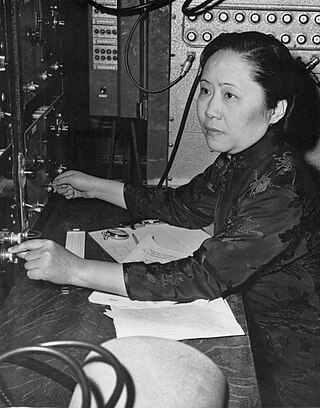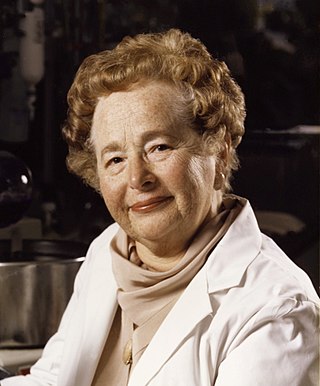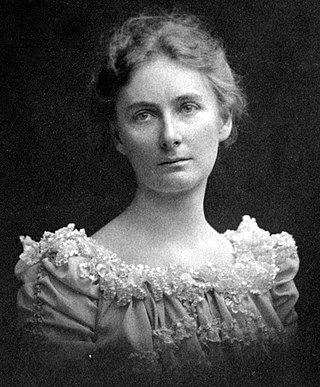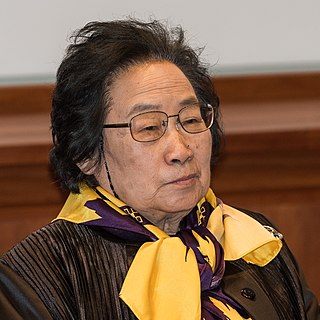Related Research Articles

The Nobel Prize in Physiology or Medicine is awarded yearly by the Nobel Assembly at the Karolinska Institute for outstanding discoveries in physiology or medicine. The Nobel Prize is not a single prize, but five separate prizes that, according to Alfred Nobel's 1895 will, are awarded "to those who, during the preceding year, have conferred the greatest benefit to humankind". Nobel Prizes are awarded in the fields of Physics, Medicine or Physiology, Chemistry, Literature, and Peace.

Chien-Shiung Wu (Chinese: 吳健雄; pinyin: Wú Jiànxióng; Wade–Giles: Wu2 Chien4-hsiung2; May 31, 1912 – February 16, 1997) was a Chinese-American particle and experimental physicist who made significant contributions in the fields of nuclear and particle physics. Wu worked on the Manhattan Project, where she helped develop the process for separating uranium into uranium-235 and uranium-238 isotopes by gaseous diffusion. She is best known for conducting the Wu experiment, which proved that parity is not conserved. This discovery resulted in her colleagues Tsung-Dao Lee and Chen-Ning Yang winning the 1957 Nobel Prize in Physics, while Wu herself was awarded the inaugural Wolf Prize in Physics in 1978. Her expertise in experimental physics evoked comparisons to Marie Curie. Her nicknames include the "First Lady of Physics", the "Chinese Madame Curie" and the "Queen of Nuclear Research".

Gerty Theresa Cori was a Bohemian-Austrian and American biochemist who in 1947 was the third woman to win a Nobel Prize in science, and the first woman to be awarded the Nobel Prize in Physiology or Medicine, for her role in the "discovery of the course of the catalytic conversion of glycogen".

Gertrude "Trudy"Belle Elion was an American biochemist and pharmacologist, who shared the 1988 Nobel Prize in Physiology or Medicine with George H. Hitchings and Sir James Black for their use of innovative methods of rational drug design for the development of new drugs. This new method focused on understanding the target of the drug rather than simply using trial-and-error. Her work led to the creation of the anti-retroviral drug AZT, which was the first drug widely used against AIDS. Her well known works also include the development of the first immunosuppressive drug, azathioprine, used to fight rejection in organ transplants, and the first successful antiviral drug, acyclovir (ACV), used in the treatment of herpes infection.
The year 1912 in science and technology involved some significant events, listed below.
The year 1997 in science and technology involved many significant events, listed below.

The presence of women in science spans the earliest times of the history of science wherein they have made significant contributions. Historians with an interest in gender and science have researched the scientific endeavors and accomplishments of women, the barriers they have faced, and the strategies implemented to have their work peer-reviewed and accepted in major scientific journals and other publications. The historical, critical, and sociological study of these issues has become an academic discipline in its own right.

Florence Bascom was a pioneer American woman geologist and educator. Bascom became an anomaly in the 19th century when she earned two bachelor's degrees. Earning a Bachelor of Arts in 1882, and a Bachelor of Science in 1884 both at the University of Wisconsin. Shortly after, in 1887, Bascom earned her master's degree in geology at the University of Wisconsin. Bascom was the second woman to earn her PhD in geology in the United States, in 1893. Receiving her PhD from Johns Hopkins University, this made her the first woman to earn a degree at the institution. After earning her doctorate in geology, in 1896 Bascom became the first woman to work for the United States Geological Survey as well as being one of the first women to earn a master's degree in geology. Bascom was known for her innovative findings in this field, and led the next generation of female geologists. Geologists consider Bascom to be the "first woman geologist in America".

This article discusses women who have made an important contribution to the field of physics.
Women in geology concerns the history and contributions of women to the field of geology. There has been a long history of women in the field, but they have tended to be under-represented. In the era before the eighteenth century, science and geological science had not been as formalized as they would become later. Hence early geologists tended to be informal observers and collectors, whether they were male or female. Notable examples of this period include Hildegard of Bingen who wrote works concerning stones and Barbara Uthmann who supervised her husband's mining operations after his death. Mrs. Uthmann was also a relative of Georg Agricola. In addition to these names varied aristocratic women had scientific collections of rocks or minerals.

Luke Chia-Liu Yuan was a Chinese-American physicist. He is the husband of the famous physicist Chien-Shiung Wu, who disproved the conservation of parity.

Mildred Cohn was an American biochemist who furthered understanding of biochemical processes through her study of chemical reactions within animal cells. She was a pioneer in the use of nuclear magnetic resonance for studying enzyme reactions, particularly reactions of adenosine triphosphate (ATP).

The Matilda effect is a bias against acknowledging the achievements of women scientists whose work is attributed to their male colleagues. This phenomenon was first described by suffragist and abolitionist Matilda Joslyn Gage (1826–1898) in her essay, "Woman as Inventor". The term "Matilda effect" was coined in 1993 by science historian Margaret W. Rossiter.

Tu Youyou is a Chinese malariologist and pharmaceutical chemist. She discovered artemisinin and dihydroartemisinin, used to treat malaria, a breakthrough in twentieth-century tropical medicine, saving millions of lives in South China, Southeast Asia, Africa, and South America.

Asian Americans have made many notable contributions to science, technology, engineering, and mathematics (STEM) fields.

This is a timeline of women in science, spanning from ancient history up to the 21st century. While the timeline primarily focuses on women involved with natural sciences such as astronomy, biology, chemistry and physics, it also includes women from the social sciences and the formal sciences, as well as notable science educators and medical scientists. The chronological events listed in the timeline relate to both scientific achievements and gender equality within the sciences.

Beyond Curie is a portrait series of women who have made significant contributions in STEM fields. As of November 2018, the series features 42 women, including all 18 female Nobel Prize winners in Physics, Chemistry, and Physiology or Medicine.
References
- ↑ Mary Wyer (2001). Women, Science, and Technology: A Reader in Feminist Science Studies. Psychology Press. p. 3. ISBN 978-0-415-92606-5.
- ↑ Oakes, Elizabeth H., Encyclopedia of World Scientists,Infobase Publishing, 2007, p. 147
- ↑ Edwin Butt Eckel (1982). The Geological Society of America: Life History of a Learned Society. Geological Society of America. p. 36. ISBN 978-0-8137-1155-3.
- ↑ "Susan La Flesche Picotte First N.A. Female Physician". Nebraska Studies. Retrieved May 28, 2019.
- 1 2 "Women of Color in STEM". Marysville University website. 9 January 2020. Retrieved 13 Jun 2020.
- ↑ "Florence Bascom papers, 1883-1938". Dla.library.upenn.edu. Retrieved 2018-07-28.
- ↑ Clary, R.M. "Great expectations: Florence Bascom (1842–1945) and the education of early US women geologists". Geological society of London Publications. Special Publications. Retrieved 10 October 2017.
- ↑ Schneidermann, Jill (July 1997). "A Life of Firsts: Florence Bascom" (PDF). GSA Today. Geological Society of America.
- ↑ "The Stone Lady, Florence Bascom (U.S. National Park Service)". Nps.gov. 1945-06-18. Retrieved 2018-07-28.
- ↑ Schneidermann, Jill (July 1997). "A Life of Firsts: Florence Bascom" (PDF). GSA Today. Geological Society of America.
- 1 2 irishawg (2016-08-20). "Women in Geoscience Series – Irish Association for Women in Geosciences". Irishawg.wordpress.com. Retrieved 2018-07-28.
- ↑ "Marie Curie Facts". Nobelprize.org. Nobel Media. Retrieved 14 Jun 2020.
- ↑ Lemelson-MIT Program
- ↑ "Engineering Education Blog: First Woman Elected to National Academy of Science". K-grayengineeringeducation.com. Retrieved 2014-02-16.
- ↑ "Medicine:Bacteriologists". Time . January 9, 1928. Archived from the original on October 20, 2012. Retrieved November 26, 2009.
- ↑ Tiffany K. Wayne (2011). American Women of Science Since 1900. ABC-CLIO. p. 514. ISBN 978-1-59884-158-9.
- ↑ Williams, Marguerite. "A History of Erosion in the Anacostia Basin". World Cat. Retrieved 8 March 2014.
- ↑ "Women's History Month – Marguerite Thomas Williams". University of the District of Columbia. Retrieved 2018-09-24.
- ↑ "The Nobel Prize in Physiology or Medicine 1947". Nobel Foundation. Retrieved 28 July 2007.
- ↑ "Gerty Cori - Facts". Nobelprize.org. 1957-10-26. Retrieved 2018-08-19.
- ↑ "Nobel Prize for Medicine 2015 winners". Erewise. Retrieved 2018-08-20.
- ↑ Biography.com Editors. "Marie M. Daly Biography". The Biography.com website. A&E Television Networks. Retrieved 13 June 2020.
{{cite web}}:|last1=has generic name (help) - ↑ Witter, Brad. "Katherine Johnson and 9 Other Black Female Pioneers in Science". biography.com. Retrieved 13 June 2020.
- ↑ Arlene B. Hirschfelder; Paulette Fairbanks Molin (2012). The Extraordinary Book of Native American Lists. Scarecrow Press. pp. 278–. ISBN 978-0-8108-7709-2.
- ↑ "'Seaweed lady' Isabella Abbott dies". Montereyherald.com. 2018-08-19. Retrieved 2018-08-23.
- ↑ "Lederberg, E. M., 1950, "Lysogenicity in Escherichia coli strain K-12", Microbial Genetics Bulletin, 1, pp. 5-9, Jan. 1950, Univ. of Wisconsin (Evelyn Maisel Witkin, Editor), Ohio State University, ISSN 0026-2579, call No. 33-M-4, OCLC 04079516, Accession Number: AEH8282UW" http://www.estherlederberg.com/Censorship/LambdaW.html
- ↑ Computer History Museum | Timeline of Computer History : Year 1952 Entries
- ↑ Wu, C. S.; Ambler, E.; Hayward, R. W.; Hoppes, D. D.; Hudson, R. P. (1957). "Experimental Test of Parity Conservation in Beta Decay" (PDF). Physical Review . 105 (4): 1413–1415. Bibcode:1957PhRv..105.1413W. doi: 10.1103/PhysRev.105.1413 .
- 1 2 William Dickie (February 18, 1997). "Chien-Shiung Wu". The New York Times . Retrieved 2014-02-16.
- 1 2 Chiang, Tsai-Chien (2014). Madame Chien-Shiung Wu: The First Lady of Physics Research. pg. 80-81. World Scientific. ISBN 978-981-4374-84-2.
- 1 2 Wang, Zuoyue (1970–80). "Wu Chien-Shiung". Dictionary of Scientific Biography. 25. New York: Charles Scribner's Sons. pp. 363–368. ISBN 978-0-684-10114-9.
- ↑ Eberhard Zeidler (17 August 2011). Quantum Field Theory III: Gauge Theory: A Bridge between Mathematicians and Physicists. Springer Science & Business Media. pp. 196–. ISBN 978-3-642-22421-8.
- ↑ "The Nobel Prize in Physiology or Medicine 1977". Nobel Foundation. Retrieved 28 July 2007.
- ↑ NASA Content Administrator (20 February 2015). "Glenn Orbits the Earth". NASA.gov.
- ↑ Shetterly, Margot Lee (22 November 2016). "Katherine Johnson Biography". NASA.gov.
- ↑ "The Nobel Prize in Physics 1963". Nobel Foundation. Retrieved 9 October 2008.
- ↑ "The Nobel Prize in Physics 1963". Nobelprize.org. Retrieved 2013-09-06.
- 1 2 Des Julie (2010). The Madame Curie Complex: The Hidden History of Women in Science. Feminist Press at CUNY. p. 163. ISBN 978-1-55861-655-4.
- ↑ "Mayer, Maria Goeppert". Astr.ua.edu. Retrieved 2013-09-06.
- ↑ Steel, Martha Vickers (2001). "Women in Computing: Experiences and Contributions Within the Emerging Computing Industry" (PDF). Computing History Museum.
- ↑ "UW-Madison Computer Science Ph.D.s Awarded, May 1965 - August 1970". UW-Madison Computer Sciences Department. Retrieved 2010-11-08.
- ↑ Tiffany K. Wayne (2011). American Women of Science Since 1900. ABC-CLIO. p. 1021. ISBN 978-1-59884-158-9.
- ↑ The Bruce Medalists: Margaret Burbidge
- ↑ "The Nobel Prize in Physiology or Medicine 1977". NobelPrize.org. Retrieved 2020-06-09.
- ↑ "ACS President: Anna Jane Harrison (1912-1998)". Acs.org. Retrieved 2014-02-16.
- ↑ "ASBMB". ASBMB. Retrieved 2018-12-20.
- ↑ "ASBMB Presidents :: 1978 – Mildred Cohn". Asbmb.org. Retrieved 2018-12-20.
- ↑ "Mildren Cohn (1913–2009) - American Chemical Society". Acs.org. Retrieved 2018-12-20.
- ↑ Angelo, Michael; Varrato, Matt (2011-10-01). "Leah Lowenstein, MD Nation's first female Dean of a co-ed medical school (1981)". 50 and Forward: Posters.
- ↑ "Barbara McClintock". Nasonline.org. 2018-03-30. Retrieved 2018-08-19.
- ↑ "The Nobel Prize in Physiology or Medicine 1983". Nobel Foundation. Retrieved 28 July 2007.
- ↑ ISSUU - BioNoticias by Biblioteca Biología
- ↑ Kolata, Gina (September 4, 1992), "Dr. Barbara McClintock, 90, Gene Research Pioneer, Dies", The New York Times, retrieved December 28, 2012
- ↑ "The Nobel Prize in Physiology or Medicine 1983", Nobelprize.org, Nobel Media AB, archived from the original on July 6, 2010, retrieved July 8, 2010
- ↑ "Former Astronaut and NOAA Administrator Kathy D. Sullivan Named National Air and Space Museum's Lindbergh Fellow". National Air and Space Museum. 2017-01-26. Retrieved 2020-06-10.
- ↑ Patricia E. Bath, US Patent 4,744,360, Apparatus for ablating and removing cataract lenses, issued May 17, 1988 (filed Dec. 18, 1986). Retrieved February 24, 2019
- ↑ "The Nobel Prize in Physiology or Medicine 1988". Nobel Foundation. Retrieved 28 July 2007.
- ↑ U.S. National Library of Medicine. "Dr. Antonia Novello". Changing the Face of Medicine website. National Institutes of Health, Health & Human Services. Retrieved 14 June 2020.
- ↑ Margaret W. Rossiter (21 February 2012). Women Scientists in America: Forging a New World Since 1972. JHU Press. pp. 249–. ISBN 978-1-4214-0233-8.
- ↑ "Society of Chemical Industry - Perkin Medal". www.soci.org. Archived from the original on 2013-03-26.
- 1 2 Stinson S (1992). "Edith M. Flanigen Wins Perkin Medal". Chemical & Engineering News. 70 (10): 25. doi:10.1021/cen-v070n010.p025.
- ↑ Hine, Darlene Clarke (2005). Black Women in America. New York, New York: Oxford University Press. pp. 140. ISBN 9780195223750.
- ↑ "Space Today Online -- Man In Space Firsts -- table of contents". www.spacetoday.org. Retrieved 2019-10-08.
- ↑ St Angelo, Steven (2014-07-01). "A farewell celebration for Nursing's Fannie Gaston-Johansson". The Hub. Retrieved 2020-03-28.
- ↑ "US NSF - Office of the Director - List of NSF Directors, 1950-present". www.nsf.gov. Retrieved 2020-06-09.
- ↑ "The Nobel Prize in Physiology or Medicine 2004". Nobel Foundation. Retrieved 28 July 2007.
- ↑ "UCSF's Elizabeth Blackburn Receives Nobel Prize in Physiology or Medicine | UC San Francisco". Ucsf.edu. 2009-10-05. Retrieved 2018-08-20.
- ↑ "The Nobel Prize in Physiology or Medicine 2009". Nobel Foundation. Retrieved 28 July 2007.
- ↑ "Marcia K McNutt".
- ↑ "Science Editor-in-Chief Marcia McNutt Elected President of the National Academy of Sciences". AAAS - The World's Largest General Scientific Society. 2016-02-16. Retrieved 2018-08-26.
- ↑ Press Release: The Nobel Prize in Chemistry 2018
- ↑ "Frances Arnold Becomes First American Woman To Win Nobel Prize In Chemistry | HuffPost". Huffingtonpost.com. 3 October 2018. Retrieved 2018-10-04.
- ↑ "Citation by the Abel Prize Committee". The Abel Prize. Retrieved March 19, 2019.
- ↑ Chang, Kenneth (March 19, 2019). "Karen Uhlenbeck Is First Woman to Receive Abel Prize in Mathematics – Dr. Uhlenbeck helped pioneer geometric analysis, developing techniques now commonly used by many mathematicians". The New York Times . Retrieved March 19, 2019.
- ↑ Murphy, Heather (2020-06-08). "First American Woman to Walk in Space Reaches Deepest Spot in the Ocean". The New York Times. ISSN 0362-4331 . Retrieved 2020-06-10.